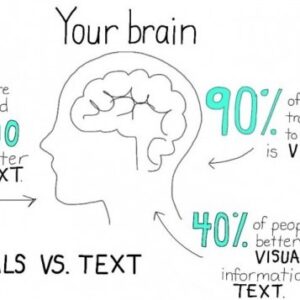
Enhancing Meaning Through Visual Imaging
Visual imaging’s impact can greatly affect your business growth. The success of your business depends on the impact of your logo and marketing strategy. A good strategy is to use is strong visual imagery. Visuals help people make sense out of the content and direct attention, increasing the possibility that your brand will be remarkable. Draftss has also helped its clients to develop substantial e-commerce platforms with unlimited graphics designs, illustrations, WordPress, HTML, and more for building your website, brand, etc. you can check on our website at draftss. To make an impact, your logo and imagery must be simple, yet impactful. Words are too difficult and very abstract for the brain to retain, whereas visuals are concrete. Visuals are processed 60,000 times faster in the brain than in text. This is brand is recognizable by seeing the visual graphic, even before reading the brand or company’s name. Visuals help people make sense out of the content and direct attention. 90% of all information transmitted to the brain is visual. This is why choosing a visual to accompany your design is very important. If your visual is containing heavy details, it will be more difficult to remember. Images can be a powerful force in design. No matter what the subject, we naturally grow interests in them. From beautiful, high-definition photos to beautiful graphics, they’re usually the first thing we see. Finding images for visual imaging’s impact You don’t have to be an artist to use images in your work. All it takes is a little creativity and a willingness to think outside the box. With the right resources, you can learn to set your designs apart. First: finding high-quality images for almost any type of project. Using stock Maybe you’re handy with a camera or have some graphic design experience—that’s great! If not, don’t panic. Countless online sources offer images for exactly this purpose. The truth is, most people (including professionals) rely on free or low-cost images called stock. Stock is perfect when you need something specific—for example, a photo of a tiny dog in a teacup—and you don’t have the time or resources to create it yourself. Choosing effective stock Most stock image sites let you browse or search their offerings. Look for results that are relevant to your project, but also unique in some way. In this example, we’ve searched for the word travel. The image below would be a fine choice because it subtly illustrates the concept but has a personal feel. They set the tone for your project but leave room for interpretation. Some stock images are just too generic to be effective. For instance, how many times have you seen a business presentation with something like the graphic below? For a more modern, professional design, avoid images that lack context or are too literal in meaning. Instead, look for imagery that’s connected to your work, but in a more subtle, relatable way. Image usage rights Almost every stock image has a license that states how it can be used. Some are very generous and ask for little or nothing in return. Others are more restrictive and can have serious legal ramifications if disobeyed. Before you use a stock image, make sure you understand the license associated with it (you might need to do some research if it isn’t clearly explained). If the license isn’t listed alongside the image, double-check the stock provider’s policies or FAQs. The importance of quality visual imaging’s impact Of course, it’s not just about content. There’s also a technical side to images, which can have a big impact on your design. It doesn’t matter if the photo you’ve chosen is absolutely perfect in every other way. If it’s blurry or pixelated, it could give the wrong impression. Look for high-quality images that are sharp, clear, and free of distortion. In general, bigger is better, because it gives you more to work with. A large, high-resolution image can always be cropped or sized down, depending on the needs of the project. Unfortunately, it doesn’t work the other way around. If you enlarge a small image—in other words, make it bigger than its original size—there will be a noticeable loss in quality. The image will become blurry and/or distorted, as in the example below. Raster vs. vector There’s a reason small images lose quality when you enlarge them. It’s because they’re built on thousands—sometimes even millions—of tiny little pixels. The word for this type of image is raster. When you view a raster image at its original size or smaller, the pixels are invisible—they’re just too small to see. They only become apparent when you zoom in or make the image larger. Vector graphics are quite different from raster. You can make them any size, big or small, without losing quality. That’s because vectors are something more complex than pixels. A special form of geometry helps to render them. You’re not likely to find vector graphics outside of professional design settings, but it’s good to know what they are. Editing images Few stock images are perfect as is, even if they’re technically high-quality ones. Maybe the image is the wrong size or the colors could use some work. Fortunately, even basic programs let you make simple adjustments. Look for these options the next time you need to fix or enhance an image. Cropping Cropping can be helpful while changing the size, shape, or focus of an image, making it useful in many different situations. Try this feature if your graphic is the wrong dimensions, or if it includes something you’d rather cut out. Resizing Resizing an image will ensure it’s the perfect fit for your project. Just remember that you can’t make an image bigger than its original size without affecting its quality. If the image you’re working with simply isn’t big enough, it’s best to choose something else. You can also find a creative way to work with the image size you have. In the example below, we’ve added a background image instead










